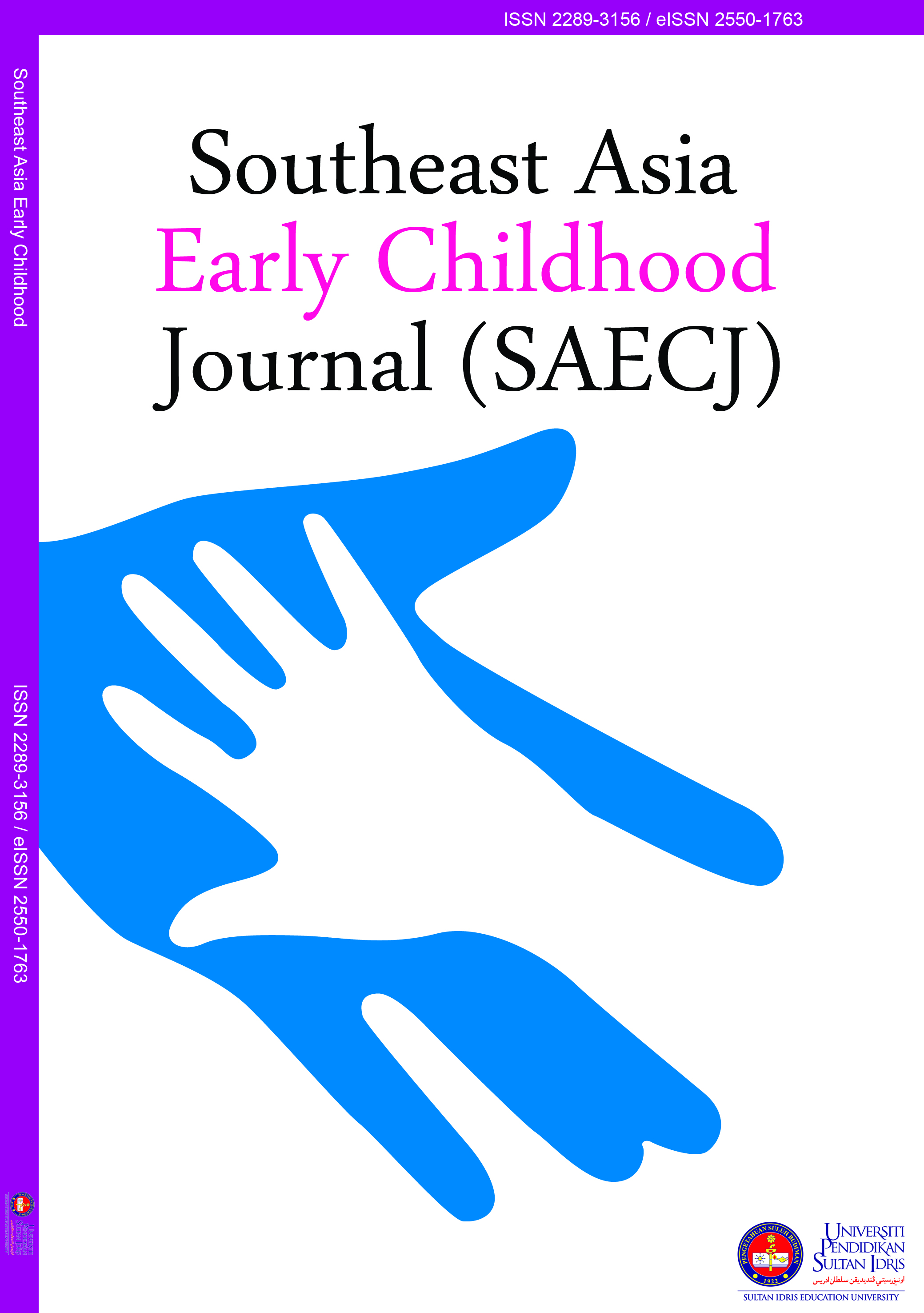Puppetry activities in early childhood programmes
DOI:
https://doi.org/10.37134/saecj.vol10.sp.8.2021Keywords:
children, puppetry, early childhoodAbstract
Puppetry plays an edutainment role in playing and learning activities for nursery and kindergarten children. This qualitative study was aimed to investigate the benefits of puppetry activities for children who were enrolled in early childhood programs. In-depth interviews were conducted with four respondents, two of whom were child care providers from the nursery and two teachers were from kindergarten. Based on the thematic analysis, it was found that the inclusion of puppetry activities in an early childhood program can boost intellect and memory; enhance creative thinking and imagination; more manageable of self-control and emotions; ensure social and interaction; allow practice in focusing; language and communication; improve physical and mental health; connected spirituality and moral values. Most importantly, the daily living skills embedded in the puppetry activities can be translated into their lives. In sum, this study proved that puppetry activities help to enhance life skills, learning experience development, and widen knowledge among nursery and kindergarten children. The study implied that puppetry activities should be integrated into early childhood education can sustain children's overall development.
Downloads
References
Caganaga, C. K., & Kalmis, A. (2015). The role of puppets in kindergarten education in Cyprus. Open Access Library Journal, (2), 1-9.
Compton, B. (2016). Children use art, puppetry to express themselves. Health Progres, 86-87.
Cvetkova, B., & Andonovska-Trajkovska, D. (2012). Role of puppet theatre in early child development. Proceedings of the 1st International Conference Education Across Borders, Greece: Florina, 661-662.
Kroflin, L. (2012). The role of puppet in language teaching. In Kroflin, L. (Eds.). The power of the puppet (pp. 46-62). Zagreb: The UNIMA Puppets in Education, Development and Therapy
Kroger, T., & Nupponen, A-M. (2019). Puppet as a pedagogical tool: A literature review. International Electronic Journal of Elementary Education, 11 (4), 393-401.
Loy Chee Luen, Aminah Ayob, & Nordin Mamat. (2015). Finger puppet activities encourages a child’s social interaction. Jurnal Pendidikan Awal Kanak-kanak Kebangsaan, 4, 29-49.
Loy Chee Luen, Goh Swee Choo, Nor Mashitah Mohd Radzi, Nordin Mamat, Wong Kung Teck, Wong Yu Hoi, & Mohd Mahzan Awang. (2020). The effects of puppet in EduwebTV Programmes on children’s National Language speaking skills. Journal of University of Shanghai for Science and Technology, 22 (12), 1159-1164.
Loy Chee Luen, Nordin Mamat, Nor Mashitah Mohd Radzi, Nurul Hasyimah Mat Rani, Mazlina Che Mustafa, Syahida Iryani Mohd Yusoff, Ramlee Ismail, Abdul Rahim Razalli, Zaharah Osman, Hashimah Hussein, Nurulhuda Md Hassan, Kaaminy Kannapathy & Sopia Md Yassin, & Mohd Mahzan Awang. (2020). Verbal and non-verbal interactions between childcare providers and children in learning activities. Palarch’s Journal of Archaeology of Egypt/Egyptology, 17(9), 3078-3084.
Loy Chee Luen. (2017). Puppets as pedagogical tools in social development and emotion of preschool children. Jurnal Pendidikan Awal Kanak-kanak Kebangsaan, 6, 45-56.
Majaron, E. (2012). Art as a pathway to child. In Kroflin, L. (Eds.). The power of the puppet (pp. 11-17). Zagreb: The UNIMA Puppets in Education, Development and Therapy Commission.
Ministry of Education Malaysia. (2017). National preschool standard-based curriculum. Curriculum Development Division, Ministry of Education Malaysia.
Nordin Mamat, Loy Chee Luen, Nor Mashitah Mohd Radzi, Nurul Hasyimah Mat Rani, Mazlina Che Mustafa, Syahida Iryani Mohd Yusoff, & Mohd Mahzan Awang. (2020). Teacher-child interactions in learning activities. Palarch’s Journal of Archaeology of Egypt/Egyptology, 17(9), 3071-3077.
Prime Minister's Department. (2013). National PERMATA Curriculum. Department Early Childhood Education, Prime Minister's Department, Malaysia.
Remer, R., & Tzuriel, D. (2015). “I teach better with the puppet”- Use of puppet as a mediating tool in kindergarten education-an evaluation. American Journal of Education Research, (3), 356-365.
Rumi Gupta. (2020). Puppetry art- A pedagogical tool in teacher education programme. Journal of Xi’an University of Architecture & Technology, XII (IV), 309-323.
Downloads
Published
How to Cite
Issue
Section
License
Copyright (c) 2021 Loy Chee Luen

This work is licensed under a Creative Commons Attribution-NonCommercial-ShareAlike 4.0 International License.





